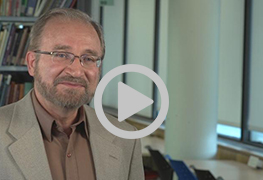Ernesto Guzman

Find Related People by Keyword
Ernesto Guzman was born and raised in Mexico, where he started to keep bees when he was 17. His interest in bee biology and beekeeping further developed when he became a TA of an introductory apiculture course at the National University of Mexico. Eventually, Ernesto kept more than 300 bee hives and produced over 10 tons of honey a year. He took several beekeeping courses in the USA and after getting a DVM degree, he moved to Davis California for graduate education in Entomology. After getting his PhD, he conducted research on the behavior and genetics of Africanized honey bees and on their resistance to parasitic mites for 12 years. Then he accepted a position at the University of Guelph where he has worked for more than 15 years. Ernesto Guzman’s research is focused on genetics, behaviour, and diseases of honey bees. Dr. Guzman is author or co-author of more than 120 peer-reviewed publications and is recognized as a world authority in honey bee breeding and parasitic diseases of bees.
Meet Prof. Ernesto Guzman
Ernesto Guzman is a professor in our School of Environmental Sciences and the Pinchin Family Chair in Honey Bee Health. His research focuses on identifying factors that affect honey bee health and behaviour.
Check out Ernesto's 60 second snapshot video here.
Academic History
- Ph.D., Entomology. University of California, Davis, CA., USA, 1992.
- M.S., Entomology. University of California, Davis, CA., USA, 1989.
- D.V.M. National Autonomous University of Mexico, Mexico D.F., 1982.
Students Advised:
Dr Guzman has advised or co-advised the theses of more than 60 DVM, MSc and PhD students
Awards and Honours
- Puerto Rico Beekeepers Association’s Apicultural Award. For contributions to the development of apiculture. San Juan Puerto Rico, USA, August, 2019.
- Pinchin Family Chair in Honey Bee Health. Endowment of 1 million dollars recognizing exceptional contributions made by Canadians on the preservation of pollinators. In this case for research on honey bee health. Guelph, ON, Canada, June, 2016.
- James I. Hambleton Award from the Eastern Apicultural Society. Established to honour outstanding scientific apicultural research. Guelph, Ontario, Canada, August, 2015.
- Distinguished Extension Award. Ontario Agricultural College, University of Guelph, 2009
- APIMONDIA (International Beekeeping Federation) Gold Medal. For the chapter “The Genetic Basis of Disease Resistance” in the book Honey Bee Pests, Predators & Diseases. XXXVII International Apicultural Congress. Vancouver, Canada, 1999
- Teaching Excellence Award. National University of Mexico, 1996
- APIMONDIA Gold Medal. For the book Diseases and Pests of Western Honey Bees (co-author of this book). XXXII International Apicultural Congress. Rio de Janeiro, Brazil, 1989
Research Impact
The Honey Bee Research Centre (HBRC) at the University of Guelph conducts broad and integrative research projects, which aim to capture insights and create new knowledge on best management practices and treatments and epidemiological approaches to understanding and improving bee and colony health and honey yield. We conduct projects aimed at understanding the biology and pathogenic effects of bee parasites and viruses, understanding the immune-related basis of honey bee resistance to diseases, understanding the effects of miticides and agricultural pesticides on the health and behaviour of honey bees, and testing new and environmentally-friendly methods of disease control. We also conduct a breeding program to select for resistance in honey bees against the mite Varroa destructor.
Current Research Projects
a). Efficacy and effects on bee health of prebiotics and probiotics for the control of the emergent parasitic fungus Nosema ceranae
The microsporidium fungus Nosema ceranae is an obligate, intracellular parasite, that has been recently discovered infecting the western honey bee, Apis mellifera. It was detected in Canada in 2007 and has been associated to cases of bee mortality. We are testing prebiotics and probiotics as well as immune inducers in the lab using caged bees to screen compounds that could have Nosema control potential. Promising compounds are then tested in field experiments.
b). Effects of neonicotinoid insecticides and/or Varroa destructor on honey bee health and behaviour
Among the neonicotinoid pesticides tested, imidacloprid and clothianidin have resulted toxic to bees, which could in part explain some of the colony losses observed in recent years, particularly after corn or soybean is planted. We conduct experiments on the effect of these pesticides on behaviour and on the expression of immune-related genes.
c). Breeding program for Varroa-resistance
The long-term solution to controlling the varroa mite is to develop strains of Varroa resistant bees. We are currently conducting a study on how to breed for varroa resistance. This project is lead by one of our graduate students in collaboration with the OBA’s Tech Transfer Team. Our previous research showed a strong correlation between grooming behavior and resistance to varroa in several populations of honey bees (Guzman-Novoa et al. 2012, Hamiduzzaman et al. 2017). We found that grooming behavior is also correlated with slow mite population growth in colonies. Therefore, our project is based on determining V. destructor population growth over a period of time in colonies. We study whether the resistant colonies are less infected with viruses and whether there are correlations, common traits and common genetic markers in the mite population growth.
Featured Publications
Guzman-Novoa, E. and N. Morfin. 2019. Disease resistance in honey bees (Apis mellifera L.) at the colony and individual levels. In: Moo-Young, M. (Ed.), Comprehensive Biotechnology, Vol. 4 (67), Elsevier: Pergamon, pp 811-817. doi: 10.1016/B978-0-444-64046-8.00254-8. ISBN: 9780444640475.
Guzman-Novoa, E., B. Emsen, P. Unger, L.G. Espinosa-Montaño, and T. Petukhova. 2012. Genotypic variability and relationships between mite infestation levels, mite damage, grooming intensity, and removal of Varroa destructor mites in selected strains of worker honey bees (Apis mellifera L.). Journal of Invertebrate Pathology 110: 314-320.
Morfin, N., P.H. Goodwin, G.J. Hunt, E. Guzman-Novoa. 2019. Effects of sublethal doses of clothianidin and/or V. destructor on honey bee (Apis mellifera) self-grooming behavior and associated gene expression. Scientific Reports 9: 5196. doi: 10.1038/s41598-019-41365-0.
Emsen, B., E. Guzman-Novoa, M.M. Hamiduzzaman, L. Eccles, B. Lacey, R.A. Ruiz-Perez, M. Nasr. 2016. Higher prevalence and levels of Nosema ceranae than Nosema apis infections in Canadian honey bee colonies. Parasitology Research 115: 175-181. doi: 10.1007/s00436-015-4733-3.
Borges, D., E. Guzman-Novoa, P.H. Goodwin. 2020. Control of the microsporidian parasite Nosema ceranae in honey bees (Apis mellifera) using nutraceutical and immuno-stimulatory compounds. PLoS ONE 15 (1): e0227484. doi: 10.1371/journal.pone.0227484.
For a full list of Dr. Guzman’s publications, please visit his Google Scholar site.
Research Area
bee biology, bee pathology, bee behaviour, bee genetics, bee ecology
